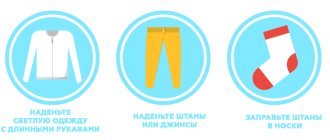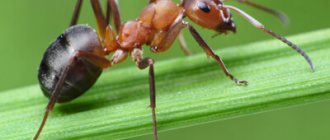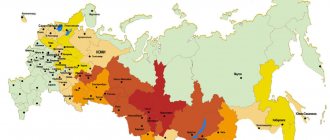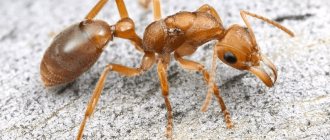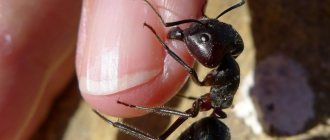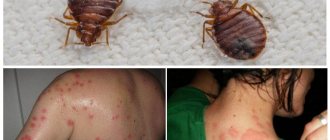The Moscow region is one of the most densely populated regions in the country. Millions of people not only have summer cottages here, but also permanently reside in these territories. Administratively, the Moscow Region includes 14 districts, 46 cities, 2 urban-type settlements and 5 ZATOs. Each of them contains thousands of hectares of forests, fields and meadows. They are the main habitat for ticks and modern cottage communities are being built in their place. Due to this invasion of nature, people receive, in addition to their real estate, a full complement of the indigenous arthropod inhabitants of these places, including those that are not the most pleasant and desirable.
Ticks will appear in the Moscow region in 2022 with the first thaw. During the winter they hibernate. In order to awaken from suspended animation, it is enough for them to have warm, sunny weather outside for several days with temperatures above +10 degrees. Immediately after resuming vital activity, hungry parasites begin to actively search for a blood donor in order to be satisfied after a long winter. Just in time, their owners are already coming to their dachas, bringing cats, dogs and children with them. People and animals spend more and more time on the street, which unspeakably pleases blood-sucking parasites of all stripes. A tick bite is always unpleasant, quite disgusting and unexpected, but in addition to stress and emotional shock, it can bring much more depressing consequences. We are talking about dangerous viral diseases that are transmitted at the time of the bite. In 2022, more than half a million people turned to doctors for help after tick bites. Of these, 10.2 thousand fell ill with encephalitis, borreliosis, hemorrhagic fever, rickettsiosis and tularemia. In Moscow, 9,361 calls to specialists were registered, 347 cases of borreliosis, and only 5 people out of this number were bitten by ticks in the capital. The rest were bitten during out-of-town trips to the region.
Unfortunately, special antidotes have not been developed for all diseases transmitted through tick bites. Most of them have to be dealt with with the help of immunostimulating drugs and, by and large, rely on the body’s own strength. The only exception is encephalitis. In 2022, almost 24 thousand people were vaccinated against this virus in Moscow alone. On the one hand, this figure looks impressive, but upon closer examination of the issue, the situation changes. There are about 1.5 million summer cottages in the Moscow region, where over 3 million people regularly vacation. If we compare the number of vaccinated and unvaccinated gardeners and summer residents, we can conclude that most people still prefer to hope for chance and believe that this problem will definitely bypass them. The vaccine does not get rid of the pest bite, but it prevents the development of the virus inside the body and increases several times the chances of remaining a healthy and alive person if an encephalitis infection does occur. The most dangerous areas from this point of view are reflected in the map of endemic areas of the Moscow region.
Ticks in the Moscow region 2022: dangerous areas
The data below for locations relates only to the number of tick bites, and not to the incidence of their total number. Ticks in the Moscow region are quite active in 2022; dangerous areas this season are distributed as follows:
- Taldomsky
- Dmitrovsky
- Serpukhovsky
- Mytishchinsky
- Likino-Dulyovo
- Pushkinsky
- Naro-Fominsk
- Voskresensky
- Sergiev Posadsky
- Istra
- Balashikha
- Lyubertsy
- Kolomna
- Podolsk
- Shatura
- Noginsky
- Ramensky
- Yegoryevsk
As can be seen from this list, bites occur almost throughout the entire region, so the fight against ticks is relevant regardless of the location of your dacha. If blood-sucking parasites annually cause you inconvenience and turn your vacation into a nightmare, prepare for the season in advance.
Collect a first aid kit for tick bites and put it in your first aid kit. Take it with you outdoors and when traveling to your country residence. It should include a special device for curing the parasite (sold at the pharmacy), ordinary tweezers, gauze, a cotton pad, thread or any other item that will allow you not to pull out the tick with your bare hands, a disinfectant and a small sealed container in which you will need to place the parasite and then send it for analysis. Write down in your phone all the phone numbers and addresses of the nearest clinics and laboratories where it will be most convenient for you to contact in case of a bite. Purchase special protective equipment in the form of spray and repellent cream. Order a comprehensive treatment of the area from ticks from the sanitary service. All these measures will help you avoid bites and infection with viral infections, even in areas where there are a lot of ticks.
Vaccination is the path to salvation
By going to the Rospotrebnadzor website and following the links to the “Sanitary and Epidemiological Situation” section, you can find a list of medical institutions that provide vaccination against tick-borne encephalitis. You may qualify for free vaccination if you live in or intend to travel to a dangerous area. The state will also provide you with vaccination if you work in these areas.
In other cases, you will have to pay for the vaccine yourself. As always, before vaccination, you have to choose which drug is best to use. We advise you to opt for drugs that are produced in Germany and Austria.
Ticks in the Moscow region 2022: map
The map below will help you understand more clearly where ticks settled in the Moscow region in 2018. The most dangerous districts of the Moscow region in terms of morbidity are Taldomsky and Dmitrovsky. They annually register the largest number of cases of human infection with tick-borne infections. Vaccination and treatment of areas in such places is more of a critical need than one of the possible developments. By ordering tick baiting from the SES, you eliminate not only the likelihood of infection, but also the likelihood of a bite. These will help you maintain peace of mind and fully enjoy your outdoor recreation without expecting your weekend to suddenly turn into a nightmare. The sight of a tick embedded in the skin can terrify a person of any gender and age, so it is better to avoid such a situation than to deal with its consequences in a panic.
You can order treatment of the area from ticks from specialists of the official SES of Moscow “Des Group”. If you have any questions about diseases transmitted by tick bites, you should contact them by calling the medical institutions closest to you.
Bite without pain
Why are ticks dangerous? The insect bite itself is really not that scary, but the infections it can carry are dangerous. In addition, mites often dig into the skin so deeply that it becomes difficult to remove them. But you still need to remove the insect so as not to leave the proboscis in the skin.
You may not feel the bite itself, since the tick's saliva has an analgesic effect. At the same time, people usually receive the bulk of pathogens in the first minutes after suction.
The Moscow Department of Rospotrebnadzor says that ticks are the main carriers of tick-borne borreliosis, monocytic ehrlichiosis, granulocytic anaplasmosis and viral encephalitis. The latter is the most dangerous - this virus can lead to death. Fortunately, encephalitis ticks are extremely rare - last year, for example, almost 13.5 thousand people suffered from tick bites went to the capital's hospitals, but there were only 14 cases of encephalitis and all were imported, that is, infected ticks attacked person in another region or country.
The Moscow region as a whole is considered free from viral encephalitis, but there are exceptions in the region - these are the Dmitrovsky and Taldomsky districts, where the risk of infection is still high. And on the territory of Moscow itself this year there has not yet been a single case of ticks sucking on them - the city is not the most suitable environment for them, although there are many parks, squares and green ponds, etc. in the metropolis.
Therefore, the Moscow Department of Health also advises caution and reminds that you can get borreliosis even without a bite. For example, you are removing a tick from an animal or person and accidentally crush it in the process. If you rub your eyes, touch your nose, lips or damaged areas of skin with infected hands, you can also get sick. However, there is no vaccine against borreliosis. Over the three months of this year, 24 people in the Moscow region alone suffered from this disease, which is 1.6 times more than during the same period in 2022 - then 15 cases of infection were recorded.
Area of distribution of encephalitis ticks
Ixodid ticks live in most climatic zones, on almost all continents. Insects easily adapt even to the most difficult conditions and are also found in the Arctic Circle .
Impressive colonies live in tropical and subtropical forests, where there is high humidity and a lot of grass. Temperate climates are no exception.
In our country, ticks live everywhere - from the taiga to semi-desert areas.
The most dangerous regions for tick-borne encephalitis:
- Volga region;
- Karelia;
- Central and Northwestern district;
- Far East.
The distribution of insects can be tracked on a map that is updated annually. But it is in the areas listed above that the epidemic level remains at its highest.
On a note! Ticks become active at the end of May and disappear with the arrival of autumn (end of October, first days of November). In a dry, humid climate, insects do not go into hibernation for a long time - long spring and warm autumn.
They do not survive in hot weather when the thermometers show more than 30 C. Suitable climate conditions are high humidity levels and temperatures from 15 to 25 C.
Life cycle and lifestyle of the ixodid tick
The biology of tick reproduction and nutrition determines when they are more active and dangerous to humans. There are three stages of development - larva, nymph and imago (mature individual). The female is twice as large as the male and the shield on her back covers 2/3 of the body. The female, filled with blood, swells to a gray pea with a diameter of up to 11 mm.
Based on the existing analogy with blood-sucking insects, in particular mosquitoes, many believe that only the female feeds on the blood of animals; this is not entirely true. Ixodid ticks feed once for each stage. It can be not only warm-blooded animals or humans; the tick parasitizes both amphibians and birds. They move quickly, but choose the suction site carefully, from an hour to two. The female, having drunk blood, mates and then moves to the soil, laying eggs on the stems of plants. She can lay up to 3000 eggs.
The hatched larvae climb onto bushes and tall grass and wait for the victim with their front legs with hooks extended forward. In appearance, the tick larva is similar to the adult, but has a dull dark color. The larva needs nutrition for development.
After sucking on the animal’s blood, the larva hides in the forest floor, moults and turns into a “nymph.” This is an analogy to the pupa in insects, with the only difference being that the nymph is active and also requires nutrition. Full development occurs in 1-1.5 years, but can take up to 4 years. The period of starvation for larvae, nymphs and adult ticks can last up to a year.
What should I do if bitten by a tick?
First of all, you need to remove the tick from the skin as soon as possible using a thread or a special veterinary device.
Svetlana Tolstova Infectious disease specialist, therapist with 15 years of experience in a city clinic. Do not use oil or other fats to remove ticks! Information about their effectiveness is a widespread misconception. After treatment with oil, the tick can “burrow” even deeper under the skin, but it is unlikely to suffocate.
Try not to kill the tick or leave its head under the skin; carefully remove it and place it in a transparent jar with a blade of grass or moistened cotton wool so that it does not die.
Take the jar with a live tick to the laboratory, where it will be examined for the presence of pathogens of serious diseases - encephalitis, Lyme disease.
Where can you find the encephalitis tick?
It is not possible to recognize a sick insect by its appearance; the virus in the blood is determined by special tests in the laboratory. The spreaders of the infection are taiga, forest and European ixodid ticks.
During hunger, their body size decreases to 3 mm , and as they become saturated, it grows to the state of an “inflated balloon.” The habitat of arachnids in the wild is grass and the lower branches of bushes. The parasite chooses open clearings, but without bright sunlight.
Ticks are not attracted to asphalt or compacted roads, coniferous forests and grass less than 7 cm long.
Habitats of encephalitis ticks
Natural Habitat:
- pastures;
- meadows;
- city parks and squares;
- deciduous, birch, spruce and mixed forests.
Arachnids hide in the grass, waiting for prey, and feed on blood. If there is no regular feeding, they are able to live without food for 1 to 2 months . At the sight of a suitable object, the tick becomes active: it clings to the animal’s fur, falls on a person’s clothing, and crawls into grass shoes.
Important! It is not recommended to remove the tick yourself. If the insect's head comes off, the wound becomes infected and the disease begins to develop. Encephalitis occurs when bitten through the blood, borreliosis - through saliva.
Climatic and time preferences of ticks
As already noted, these arthropods are common in all climatic zones of the Earth, are very tolerant of temperature changes and can be in a state of starvation for a long time. But favorable conditions for reproduction determine the period of tick activity. When the air temperature rises in certain hours from 10°C, when the forest floor is heated by the sun, forest ticks emerge from hibernation.
The end of March - the beginning of April is the time when these arthropods can already be found, but night frosts and periodic cold precipitation restrain their activity. Having moved onto the body of a warm-blooded animal, the tick feels comfortable and makes an attempt to suction. Already during this period, a person should take safety measures against bites of ixodid and pasture ticks.
Why is a parasite bite dangerous?
Many people have heard the term “tick-borne encephalitis”. In Moscow and the Moscow region, however, the risk of infection is minimal. Carriers of tularemia and Lyme disease (borreliosis) are more common here. One of the first symptoms of the latter is erythema migrans of Afzelius-Lipschütz, when a red spot grows around the bite, as in the photo below. The inside fades, leaving a brighter ring.
Similar smaller lesions occur in other parts of the body due to the spread of parasites (Borrelia). Symptoms of Lyme disease also include:
- temperature increase;
- joint pain;
- nausea;
- photophobia.
Without treatment, Borrelia affects internal organs. In particular, the brain. Without intervention, the disease can cause irreversible changes in the body.
The causative agents of tularemia also cause pain and fever. A characteristic sign of the disease is facial puffiness. The risk of death from tularemia without timely treatment is estimated at 6%. After recovery, immunity is formed.
Even a bite from a “pure” parasite is dangerous. Tick saliva can trigger an allergy attack. If removed incorrectly, or if the parasite bursts, the remaining head in the skin will cause inflammation.

